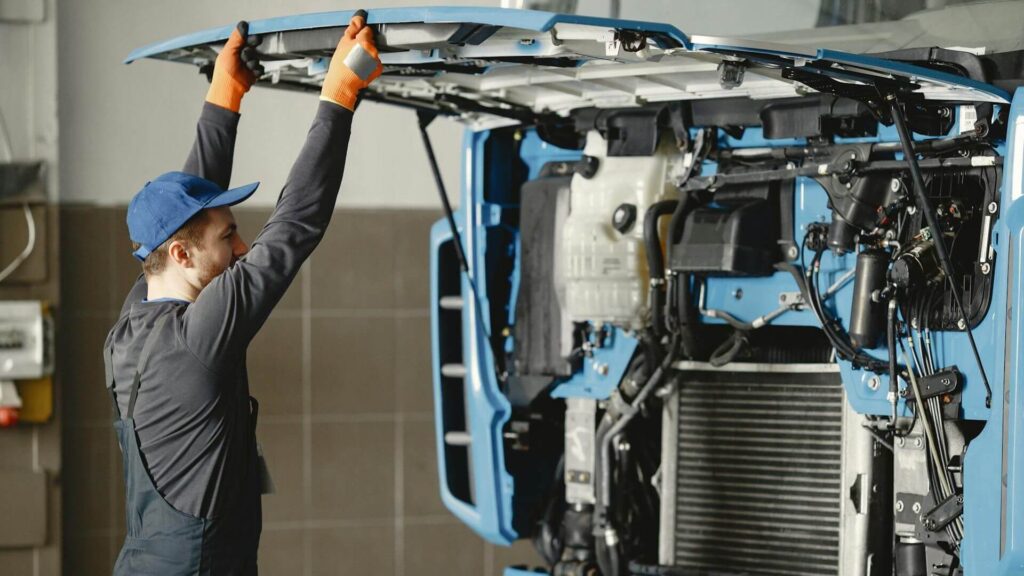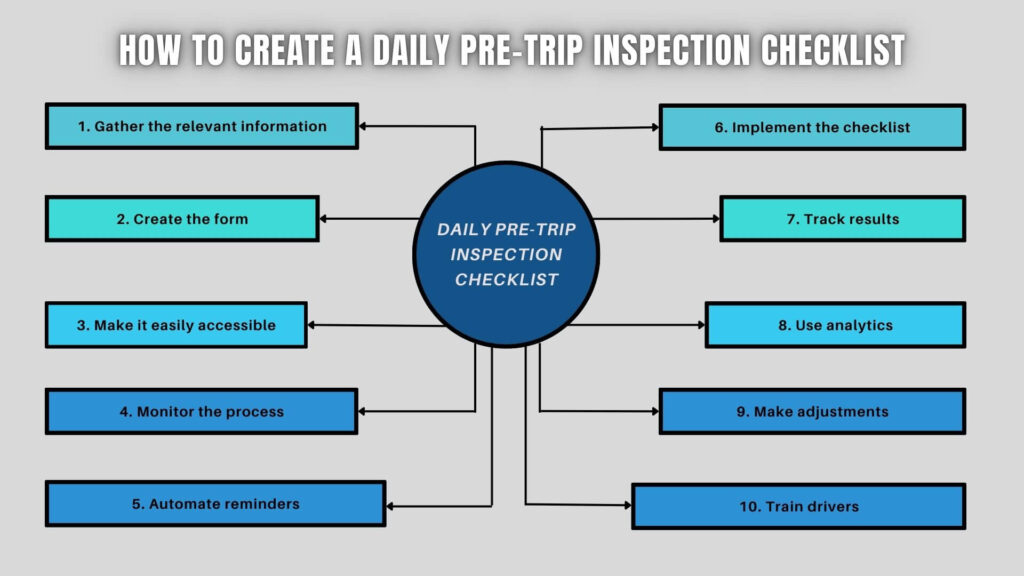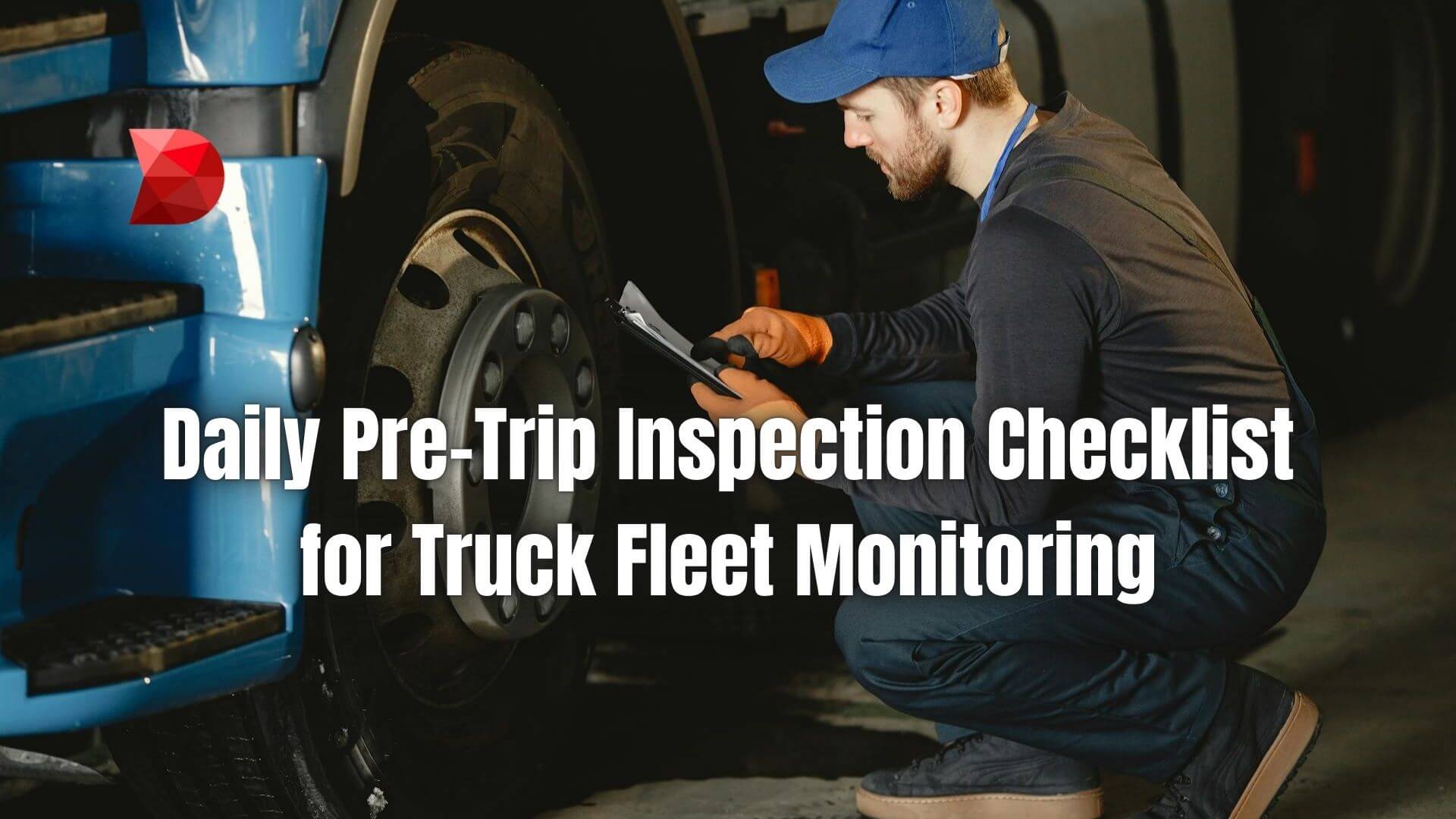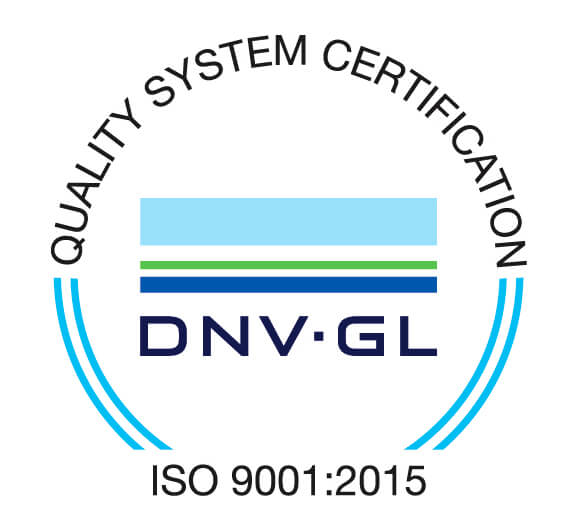A comprehensive daily pre-trip inspection is the cornerstone of effective truck fleet management. By diligently examining every component of a truck before each journey, fleet owners can significantly reduce the risk of breakdowns, accidents, and costly repairs. This article will delve into the essential elements of a daily pre-trip inspection checklist and explain how it contributes to overall fleet efficiency and safety.
Table of Contents
ToggleWhat is a Pre-Trip Inspection?

A pre-trip inspection is a mandatory examination of a vehicle conducted daily before operation to verify its roadworthiness. Drivers use a checklist to systematically identify potential issues with the truck, such as mechanical problems, tire wear, or lighting failures. By catching problems early, pre-trip inspections help prevent breakdowns, accidents, and delays.
Failing to perform a pre-trip inspection can have serious consequences. Not only does it endanger the driver and other road users, but it can also lead to legal penalties, damage to a company’s reputation, and increased operating costs due to unexpected repairs.
Why Pre-Trip Inspections are Often Overlooked
While pre-trip inspections are crucial for road safety, many drivers neglect this essential task. Here are the primary reasons why:
Time Constraints
Truck drivers often operate under tight schedules, with delivery deadlines and route constraints. Performing a thorough pre-trip inspection can be time-consuming, requiring careful examination of various vehicle components.
Drivers may feel pressured to complete the inspection quickly to minimize delays and maintain their schedules. This rush can lead to superficial inspections, overlooking potential issues.
Process Complexity
A comprehensive pre-trip inspection involves more than just a visual check. Drivers must examine specific components, such as tires, lights, brakes, and engine compartments.
They also need to document any problems or defects accurately. This detailed process can be overwhelming, especially for drivers who are already fatigued or under pressure. The added task of documentation may further discourage drivers from performing thorough inspections.
Paperwork Burden
Traditional paper-based pre-trip inspection forms can be time-consuming to complete. Drivers must fill out detailed checklists, often in duplicate, and submit them to their supervisors.
This paperwork can be cumbersome and inefficient, especially for drivers who make multiple trips in a day. The administrative burden associated with paper-based inspections can contribute to driver frustration and neglect of this essential task.
Why are Pre-Trip Inspections Important?
Pre-trip inspections are crucial to maintaining vehicle safety and fleet efficiency. By systematically checking a vehicle before each trip, drivers and fleet managers can identify potential problems early on and prevent costly breakdowns and accidents.
Improved Safety
Regular pre-trip inspections significantly reduce the risk of accidents. By carefully examining vehicle components such as tires, brakes, lights, and steering, drivers can identify and address potential hazards before they become serious issues. This proactive approach helps protect both drivers and other road users.
Legal Compliance
Many jurisdictions require commercial drivers to conduct pre-trip inspections and maintain detailed records. Failing to comply with these regulations can result in hefty fines and penalties. By consistently performing and documenting pre-trip inspections, fleets can avoid legal trouble and maintain a strong reputation.
Increased Vehicle Lifespan
Early detection of minor issues through pre-trip inspections helps prevent them from escalating into major problems. Addressing small problems promptly can extend the overall lifespan of a vehicle, reducing the need for costly repairs and replacements. This ultimately leads to lower maintenance costs and better vehicle performance.
Cost Savings
Preventing breakdowns through pre-trip inspections helps avoid costly roadside repairs, towing fees, and lost productivity. Additionally, well-maintained vehicles tend to consume less fuel and require fewer repairs, resulting in overall fleet cost savings.
Enhanced Fleet Efficiency
Pre-trip inspections help maintain fleet uptime and productivity by identifying and addressing vehicle problems before they cause breakdowns. This means fewer delays, improved delivery schedules, and better customer satisfaction.
Pre-Trip Inspection Requirements

Before operating a commercial vehicle, drivers must conduct a thorough pre-trip inspection to ensure the vehicle is safe for the road. Transportation regulations mandate this inspection and includes several key components:
1. Vehicle Condition Assessment
The primary goal of a pre-trip inspection is to verify that the vehicle is in safe operating condition. This involves a careful examination of various components, such as tires, brakes, lights, steering, and engine systems. Drivers must ensure that all safety equipment, including emergency exits, fire extinguishers, and first aid kits, is present and in good working order.
2. Inspection Report Review
If a previous inspection report exists for the vehicle, drivers must review it to identify any reported issues. This review helps determine if necessary repairs have been completed and if any ongoing concerns require attention.
3. Driver Certification
After completing the inspection, drivers must sign and date the inspection report. This signature confirms that they have conducted a thorough examination and believe the vehicle is safe to operate. If any issues are found during the inspection, the driver must document them on the report and certify that the vehicle will not be operated until the problems are corrected.
4. Driver Vehicle Inspection Report (DVIR)
If a driver discovers any vehicle defects or deficiencies during the inspection, they must complete a Driver Vehicle Inspection Report (DVIR). This report details the specific problems found, including their location and severity. The DVIR also includes information about the vehicle, driver, and carrier. The vehicle must be taken out of service until the identified issues are repaired.
By following these requirements and completing thorough pre-trip inspections, drivers can help prevent accidents, reduce breakdowns, and ensure compliance with transportation regulations.
What is a Daily Pre-Trip Inspection Checklist?
A daily pre-trip inspection checklist is a tool designed to help monitor trucks effectively by providing detailed information about the vehicle’s daily condition before each journey. This information eliminates potential risks and disruptions to fleet operation. In addition, it makes it easy to track maintenance schedules, detect problems early, and ensure compliance with safety regulations.
What to Check During a Pre-Trip Inspection?
The specific items included in a pre-trip inspection can vary based on local regulations and the type of vehicle. However, a thorough inspection typically covers key areas. With that said, here are some of the areas that you should cover during a pre-trip inspection.
1. Vehicle Exterior
- Tires: Check for proper inflation, tread wear, damage, and foreign objects.
- Wheels and Rims: Inspect for cracks damage and secure lug nuts.
- Lights and Reflectors: Ensure all lights, including headlights, taillights, brake lights, turn signals, and emergency flashers, are working correctly.
- Windshield and Wipers: Verify windshield clarity and wiper function.
- Mirrors: Check for proper alignment, cleanliness, and absence of cracks.
- Body: Inspect for dents, scratches, or any signs of structural damage.
2. Vehicle Interior
- Seat Belts: Verify proper function and condition.
- Horn: Test for clarity and functionality.
- Emergency Equipment: Check the availability and condition of the fire extinguisher, first aid kit, warning devices, and other required items.
- Driver’s Seat: Adjust for comfort and visibility.
- Controls: Ensure proper operation of the steering wheel, brakes, accelerator, and other controls.
3. Under the Hood
- Engine Oil: Check level and condition.
- Coolant: Verify level and condition.
- Brake Fluid: Inspect the level and check for signs of leaks.
- Power Steering Fluid: Check level and condition.
- Battery: Assess condition, terminals, and secure mounting.
- Belts and Hoses: Look for signs of wear, cracks, or leaks.
- Air Filters: Inspect for dirt and debris.
4. Additional Checks
- Fuel Level: Ensure sufficient fuel for the planned trip.
- Cargo Securement: Verify proper loading and securing of cargo (if applicable).
- Coupling System (for trailers): Inspect for damage, wear, and proper connection (if applicable).
Note: The content above is also the same as what you should include in your daily pre-trip inspection checklist. By consistently performing thorough pre-trip inspections, you can significantly improve vehicle safety, reduce breakdowns, and extend the life of your vehicle.
Benefits of Using a Digital Pre-Trip Inspection Checklist
Fleet managers often struggle to keep track of daily pre-trip inspections and ensure that vehicles comply with safety regulations. A digital pre-trip inspection checklist can help with the following:
Improve Fleet Safety and Compliance
A digital pre-trip inspection checklist can help fleet managers stay current on vehicle safety standards and quickly identify and address potential issues. Pre-trip inspections provide a comprehensive overview of vehicle safety and help ensure compliance.
Reduce Vulnerability To Accidents
By using a digital pre-trip inspection checklist, fleet managers can quickly identify and address any safety issues before they become a problem. This helps reduce the chances of an accident or disruption to fleet operations.
Save Time and Money
A digital pre-trip inspection checklist helps streamline the pre-trip inspection process and save time, which can ultimately result in cost savings. This improved workflow also eliminates the need for manual paperwork and reduces the risk of human error.
Ensure Quality Control
Using a digital pre-trip inspection checklist helps fleet managers keep track of all pre-trip inspections and quickly address any quality issues. This provides an easy way to identify problems and ensure that all pre-trip inspections are completed accurately and in a timely manner.
How to Create a Daily Pre-Trip Inspection Checklist
Creating a digital pre-trip inspection checklist is simple and can be done in just a few steps.

- Gather the relevant information: Start by gathering all the relevant information you need to include on your checklist, including the items listed above.
- Create the form: Use a digital solution such as Microsoft Word to create a pre-trip inspection checklist form.
- Make it easily accessible: Ensure the pre-trip inspection checklist is readily available to all drivers and vehicle operators.
- Monitor the process: Regularly monitor and review the pre-trip inspection checklist to ensure it is being filled out correctly and in a timely manner.
- Automate reminders: Set up automated reminders to ensure the pre-trip inspection checklist is completed before each trip.
- Implement the checklist: Once you have created a daily pre-trip inspection checklist and developed processes to ensure completion, implement it into your fleet operations.
- Track results: Keep track of all pre-trip inspection checklist results and use the data to identify areas for improvement.
- Use analytics: Use analytics better to understand the effectiveness of your pre-trip inspection checklist and make necessary changes.
- Make adjustments: Regularly review the pre-trip inspection checklist and make any necessary adjustments.
- Train drivers: Ensure all drivers are trained and knowledgeable on completing the pre-trip inspection checklist.
Creating and implementing a daily pre-trip inspection checklist allows you to conveniently monitor your truck fleets and ensure daily pre-trip inspections are completed. This can proactively reduce risks and prevent disruptions to fleet operations.
Frequently Asked Questions (FAQs)
Q1: How often should a daily pre-trip inspection be conducted?
A daily pre-trip inspection should be performed before a commercial vehicle is operated every day. This is a mandatory requirement to ensure road safety.
Q2: What is the ideal time allocation for a thorough pre-trip inspection?
While the time can vary based on the vehicle’s size and complexity, a general guideline is to allocate at least 30 minutes for a comprehensive inspection. However, it’s essential to prioritize thoroughness over speed.
Q3: Can I use a pre-trip inspection checklist template?
Absolutely. Using a pre-trip inspection checklist template is highly recommended. It helps ensure consistency and reduces the chances of missing critical items during the inspection. Many templates are available online for free.
Q4: What should I do if I find a problem during the pre-trip inspection?
If you discover any issues during the inspection, you should immediately report them to your supervisor or fleet manager. The vehicle should not be operated until the problem is resolved. Complete a Driver Vehicle Inspection Report (DVIR) to document the issue.
Q5: How detailed should the documentation be for a pre-trip inspection?
Documentation should be clear, concise, and accurate. It should include the date, time, vehicle identification number, driver’s name, and a detailed list of any defects or deficiencies found during the inspection.
Q6: What are the potential consequences of skipping a pre-trip inspection?
Skipping a pre-trip inspection can lead to serious consequences, including accidents, vehicle breakdowns, and legal penalties. It also puts the driver, other road users, and the company’s reputation at risk.
Conclusion
A daily pre-trip inspection is a critical component of safe and efficient fleet operations. By conducting thorough inspections, you can significantly reduce the risk of accidents, breakdowns, and costly repairs.
This article has outlined the importance of pre-trip inspections, the key components to check, and the potential consequences of skipping this crucial step.
Our goal was to provide you with essential information to create a comprehensive pre-trip inspection checklist and to emphasize the importance of making it a daily habit. By implementing a robust pre-trip inspection program, you can improve safety, reduce costs, and enhance overall fleet performance.
We encourage you to download a pre-trip inspection checklist template to get started. By making pre-trip inspections a non-negotiable part of your daily operations, you’re taking a proactive step toward a safer and more efficient fleet.
Streamline Pre-Trip Inspections with DATAMYTE
DATAMYTE is a quality management platform with low-code capabilities. Our Digital Clipboard, in particular, is a low-code workflow automation software that features a workflow, checklist, and smart form builder. This tool lets you create a digital daily pre-trip inspection checklist, ensuring all necessary checks are systematically documented and performed efficiently.
DATAMYTE also lets you conduct layered process audits (LPA), a high-frequency evaluation of critical process steps, focusing on areas with the highest failure risk or non-compliance. Conducting LPA with DATAMYTE lets you effectively identify and correct potential defects before they become major quality issues.
With DATAMYTE, you have an all-in-one solution for optimizing and simplifying the pre-trip inspection process, ensuring compliance and safety standards are consistently met. Book a demo now to learn more.



